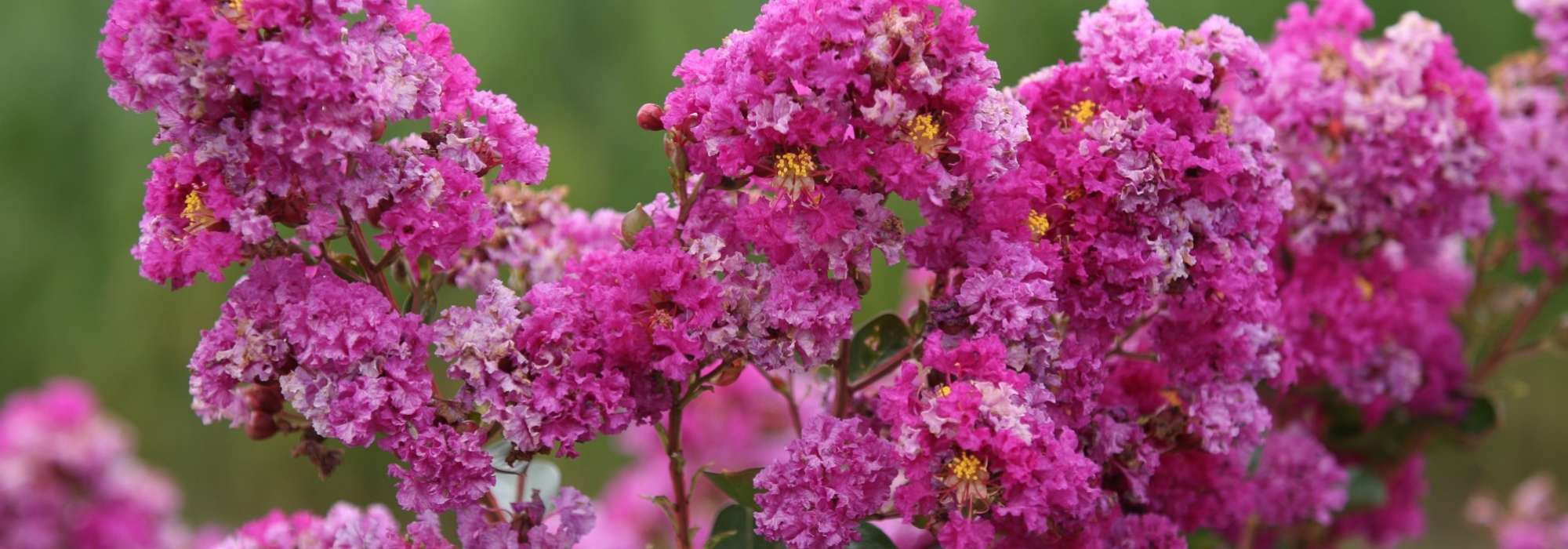
Lagerstroemia, Indian lilac: planting, growing and care
Contents
Lagerstroemia in a nutshell
- Lagerstroemia, also known as Indian Lilac, is a beautiful bush or small tree with a spectacular summer flowering in shades of Indian pink, red, mauve, or white.
- Its ornamental foliage ignites in autumn, taking on hues ranging from purple to orange-red.
- Its remarkable bark and elegant silhouette are appreciated, making it very decorative even in winter.
- Quite hardy and low-maintenance, it only requires full sun and warmth.
- Some varieties are quite small and adapt perfectly to pot cultivation!
A word from our expert
Lagerstroemia or crape myrtle is a spectacular and refined bush. Its vibrant flowering occurs from July to September in Indian pink, incandescent red, or baroque white. To maintain attention, its foliage ignites autumn with purple and orange-red hues. In winter, it becomes delicate, revealing a remarkable bark, satin-like, in a cinnamon colour marbled with soft pink and cream tones. With the subtle colours of its branches and its slightly twisted habit, the Indian lilac elegantly embraces winter’s nakedness. Conversely, its deciduous nature further highlights its architecture and the appearance of its branches!
Thanks to its good hardiness (down to -15°C), it can be grown in most of our regions, although it prefers a warm, sunny location to fully showcase its flowering.
Crape myrtle has a natural habit of coppice shoots, but it can also be trained as a standard or pruned into a small graphic bush. There are also varieties of small growth, which are perfect in pots! It is the ideal bush when space is limited in the garden: it is beautiful all year round and can be contained within acceptable volumes.

Inflorescences of a crape myrtle (photo Otota Dana)
Description and uses
Botanical data
- Latin name Lagerstroemia indica
- Family Lythraceae
- Common name crape myrtle, summer lilac
- Flowering July to September
- Height often between 2 and 7 m, sometimes less for dwarf varieties
- Exposure full sun
- Soil type any well-drained soil, rather rich and cool. Tolerates drought once established
- Hardiness -15°C
Although it is nicknamed Indian Lilac, Lagerstroemia is actually native to China. Introduced to the Indian subcontinent for its beauty, it was later brought to England around 1740, and subsequently to France. There are about thirty species, but the most well-known and cultivated in gardens is Lagerstroemia indica, along with the many horticultural varieties it has given rise to. The species Lagerstroemia fauriei and Lagerstroemia speciosa are also cultivated.
The summer lilac is a deciduous bush, with dark green foliage that turns bright red in autumn. The leaves are leathery, with a very short petiole, almost absent (they are said to be subsessile). They are opposite, entire, ovate, and pointed (acuminate). The foliage appears late in spring and disappears in late autumn, highlighting the architecture of the bush. The branches are quadrangular.
In July, the flowers bloom in panicles 10 to 20 cm long. Each flower consists of 6 crumpled, frilled petals with wavy edges, and numerous yellow stamens. This frilliness has earned it the nickname crape myrtle or muslin flower. Depending on the varieties, the flowering comes in shades of pink, from the lightest to fuchsia, but can also be red, mauve, or white. The flowering of Lagerstroemia is truly impressive! The flowers are abundant, vividly coloured, and tend to hide the foliage during summer.
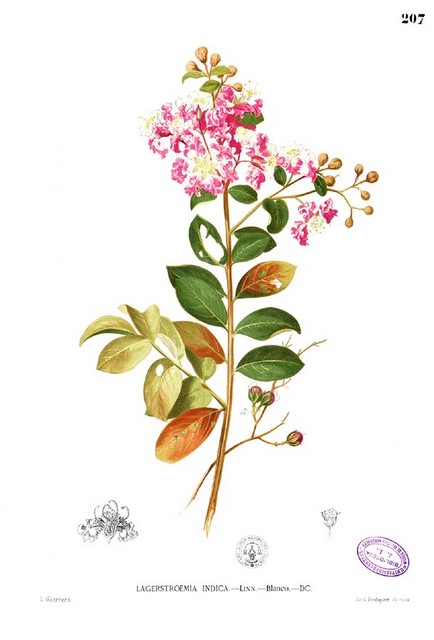
Lagerstroemia indica – botanical illustration
Its small fruits, less than 1 cm in diameter, ripen in dark capsules containing a multitude of small winged seeds. They are toxic.
Its natural habit is bushy, but it can be trained as a standard, meaning forming a single trunk, from the top of which branches, leaves, and inflorescences spread out. Thanks to its compact size and non-invasive roots, it can be planted close to buildings or networks. This is a great advantage: placed near a window, its foliage will provide light shade on warm days, but in winter, its magnificent bare branches will let light through. In this case, choose small trees like Lagerstroemia indica ‘Natchez’ with huge white spikes.
When maintaining its natural habit, Lagerstroemia presents an elegant silhouette, somewhat twisted, reminiscent of Japanese maples. At its feet, small spring bulbs, ferns, and hostas with broad leaves create a perfect illusion, especially if one chooses varieties with more subdued colours, such as L. indica ‘Pink Grand Sud’.
A polymorphous bush, its uses are vast. It can be placed in isolation to highlight its flowering and habit, whether it is in coppice or trained as a standard. You would then choose tall varieties, like L. indica ‘Violaceae’, while the Lagerstroemia indica ‘Mardi Gras’, slightly prostrate and not exceeding 1 m in height, would be wonderful in rockeries or in a pretty pot. Indian lilacs integrate beautifully at the back of a flowerbed or in a free hedge, where they will add a touch of exoticism with their unusual colours.
Lagerstroemia is easily grown in pots, which is an even greater advantage, as it is beautiful in every season! Among many small cultivars, Lagerstroemia indica ‘Berlingot Menthe’, which does not exceed 1.5 m and boasts small frilled Indian pink flowers edged in white, will stylishly decorate a balcony in a warm, sunny position.
Its ability to withstand severe pruning, the aesthetic appeal of its habit, and the beauty of its bark make it an ideal candidate for bonsai formation.

Colour palette of flowers: Lagerstroemia indica ‘Pixie White’, Lagerstroemia indica ‘Colour Palette of Summer’, Lagerstroemia indica ‘Lilac Grand Sud’ (©Hortical Diffusion), Lagerstroemia indica ‘Pink Velours’ (photo Jimthe), Lagerstroemia indica ‘Dynamite’ (©Minier)
The main varieties of Lagerstroemia
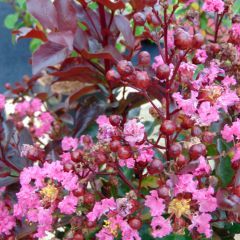
Lagerstroemia indica Rhapsody in Pink - Crape Myrtle
- Flowering time September to November
- Height at maturity 2,50 m
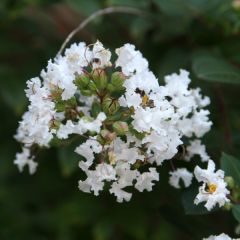
Lagerstroemia indica Pixie White - Crape Myrtle
- Flowering time August to October
- Height at maturity 1,20 m
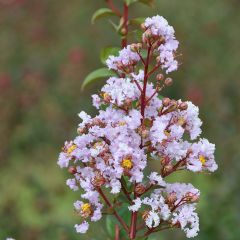
Lagerstroemia indica Camaïeu dEte Indycam - Crape Myrtle
- Flowering time August to October
- Height at maturity 2,25 m

Lagerstroemia indica Dynamite - Crape Myrtle
- Flowering time August to October
- Height at maturity 4 m

Lagerstroemia indica Lilac Grand Sud - Crape Myrtle
- Flowering time August to October
- Height at maturity 3,20 m
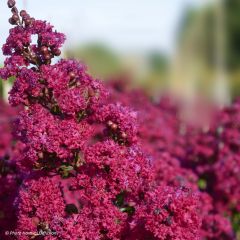
Lagerstroemia indica Braise dEté Indybra - Crape Myrtle
- Flowering time August to October
- Height at maturity 3,50 m
→ to read, for further information:
- “Crape myrtle, Lagerstroemia: which variety to choose?”
- “Crape myrtle, Lagerstroemia: 6 perfect dwarf varieties for pot cultivation”
Discover other Lagerstroemia - Crape Myrtle
View all →Available in 1 sizes
Available in 1 sizes
Available in 2 sizes
Available in 2 sizes
Available in 1 sizes
Available in 1 sizes
Available in 1 sizes
Available in 1 sizes
Available in 2 sizes
Available in 2 sizes
Planting Lagerstroemia
Where to plant?
Lagerstroemia needs warmth: choose a well-sunny spot that is sheltered from the wind. It is content with ordinary soil but prefers slightly acidic, cool, and well-draining grounds. It does not like calcareous soils or areas that retain moisture in winter. Once mature, it is capable of withstanding drought. Similarly, it is quite resistant to pollution, making it suitable for urban settings.
While it is true that it prefers a certain level of atmospheric humidity, once well established, it can endure dry and scorching summers! Its only requirements for spectacular flowering are sun and warmth.
You can plant it in a hedge, position it at the back of a border, in front of perennials, or plant it as a solitary specimen in the middle of a short grass meadow to highlight its unique architecture. Lagerstroemia can also be grown in a pot and adapts quite well to small gardens. However, for the best development of the tree, it is ideal to plant it in the ground.
When to plant?
In regions with a mild climate, the ideal time to plant Lagerstroemia is autumn (October-November): the still-warm soil encourages good root establishment, and the rains will spare you from regular watering following planting. You will still need to water the following summer until the bush is well established.
In cooler regions, prefer planting in April-May, as this will allow it to settle in well and take advantage of the summer before facing winter. However, if you plant in spring, it will be important to water abundantly during the summer.
How to plant?
In the ground:
- Place the container in a bowl of water to thoroughly hydrate the root ball.
- Dig a hole 2 to 3 times the size of the root ball.
- Remove the bush from its pot and prepare the root hairs: untangle the roots around the root ball and cut any damaged or twisted roots.
- Fill the bottom of the hole with a mixture of soil and well-decomposed compost. If your soil is very heavy, lay a bed of gravel or pumice for drainage beforehand.
- Position the plant, spreading the roots out.
- Backfill the hole with the soil and potting mix (possibly with gravel if your soil is heavy). Ensure that the collar (the junction point between the roots and the trunk) is level with the soil surface.
- Create a mound of soil around the planting hole to form a basin that will retain water.
- Lightly firm the soil and water generously to ensure the planting soil adheres well to the root ball.
After planting, we recommend applying a mulch (wood chips, leaf litter, etc.) to keep the soil cool.
In a pot:
Choose a pot that is at least 60 cm high to allow the roots to spread comfortably. Ensure there are drainage holes for water to escape.
- Hydrate the root ball in water for at least 15 minutes,
- In the meantime, create a drainage layer at the bottom of the pot with clay balls, for example (avoid materials that will weigh down the pot),
- Fill the pot with a mixture of soil, well-decomposed compost, and coarse sand (2/1/1).
- Place the root ball upright and fill in with the mixture of soil, compost, and coarse sand. Ensure that the collar is not buried.
- Lightly firm the soil and water generously.
- Apply mulch to maintain moisture.
Maintenance and Pruning of the crape myrtle
Maintaining a Lagerstroemia grown in open ground
Lagerstroemias are not particularly demanding, but an application of organic fertiliser each autumn will ensure good health and enhance flowering the following summer. Choose compost, ground horn, or well-decomposed manure.
Watering should be regular during the first year after planting, and even the second year in case of drought. After that, the bush becomes more resilient and better withstands dry periods.
Maintaining a Lagerstroemia grown in a pot
In pots, the substrate depletes quickly, which is why you will need to make several applications of fertiliser during the growing season, particularly in spring and summer. Additionally, waterings will need to be more frequent than in open ground. Allow the substrate to dry out between each watering.
In regions where the risk of severe frosts is higher, you can wrap the pot with layers of straw, bubble wrap, or horticultural fleece to protect your crepe myrtle. Place it sheltered from the wind, against a south-facing wall, and insulate it from the ground by elevating it. You can also store it in a cool, bright location (as you would for citrus trees, for example). Lagerstroemia requires a relatively cold period to enter dormancy: avoid keeping it in a heated greenhouse or conservatory during winter.
Pruning the Crape Myrtle
Lagerstroemia can do without pruning, but it is beneficial for rejuvenating an old specimen or if your Lagerstroemia is not flowering, or flowering very little.
The ideal time for pruning is at the end of winter, from February to early March.
To prune your crape myrtle, cut the branches that cross each other and keep the shoots that grow outward from the bush or crown. To encourage sunlight penetration and thus flowering, thin out the centre of the bush and the excess shoots from overloaded main branches. Remove the suckers that grow at the base of the bush, except to renew an ageing main branch. This pruning, which lightens the bush, also limits fungal diseases that proliferate in confined spaces.
You can also:
- clear the base of the trunk(s) to highlight them.
- select a shoot to train into a stem that will become a single trunk. You will then just need to eliminate the appearance of new shoots at the base of the trunk.
Finally, remember to disinfect the blade between each bush to avoid potential contamination.
→ For more information on pruning, discover our article: “Crape Myrtle, Lagerstroemia: when and how to prune it?” and our tutorial How to prune a crape myrtle?
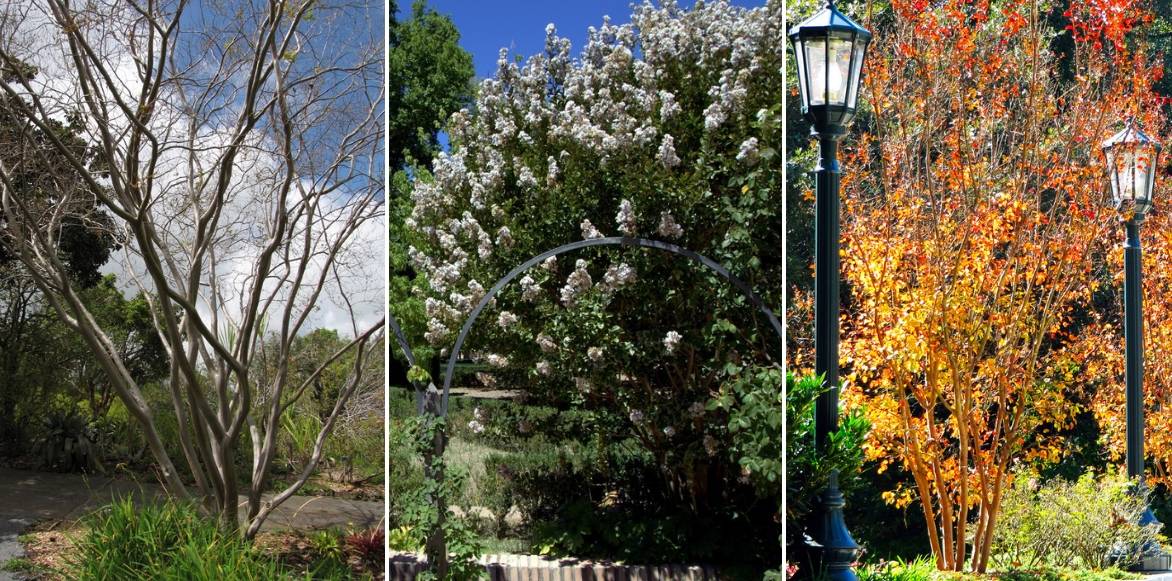
The crape myrtle through the seasons: Beautiful natural silhouette at the end of winter (photo Forest and Kim Starr) / Lagerstroemia in full summer bloom (photo Manuel m.v.) / Fiery foliage in autumn (photo David)
Diseases and pests
Crape myrtles are sensitive to powdery mildew, a disease caused by microscopic fungi, which is noticeable by the appearance of a white fluff on the foliage. Some simple actions can help limit or even prevent the occurrence of powdery mildew. Here’s what you can do as a preventive measure:
- Water at the base of the bush without wetting the foliage,
- Encourage air circulation within the bush by opting for an open pruning style,
- Space out the plantings,
- Avoid excessive nitrogen enrichment.
As a preventive measure or for treatment in case of a light attack, you can use natural preparations such as nettle manure or horsetail decoction. If this is not sufficient or if the attack is more severe, treat with a sulphur-based fungicidal product.
Also, see our article dedicated to powdery mildew as well as Diseases and pests of crape myrtle or Lagerstroemia.
Multiplication: sowing, cutting
Crape myrtle can be propagated by sowing, but this process takes longer than other techniques such as propagation by cuttings. Additionally, the plants obtained may differ from the parent plant (especially if it is a horticultural variety). Nevertheless, it can be fun to try your luck! Be aware that the new seedlings from your sowing will take 3 to 5 years before flowering. To multiply Lagerstroemia, propagation by semi-woody cuttings at the end of summer seems to be the most effective method of propagation.
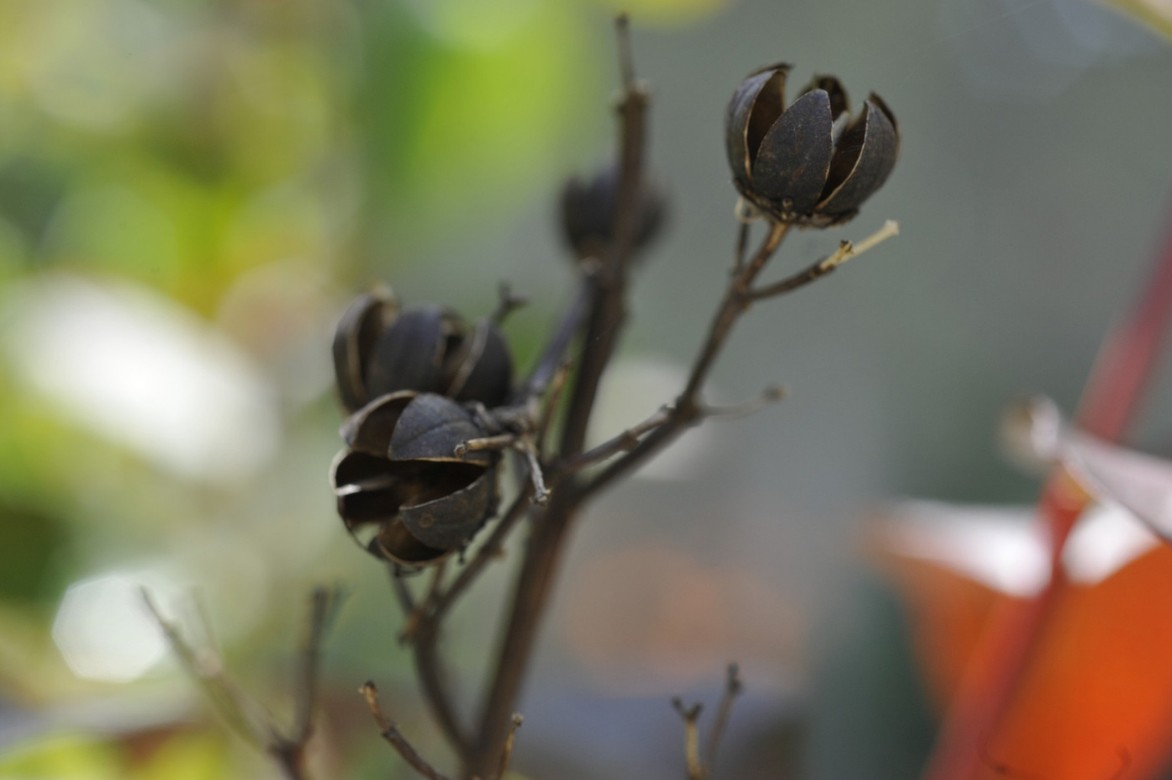
Seed capsules of Lagerstroemia ‘Arapaho’ (photo Megan Hansen)
Sowing Lagerstroemia
- Place the seeds in the cold for a month (vernalisation)
- Then soak them in warm water for 24 hours
- Sow in a special sowing compost, then lightly cover
- You can sprinkle a thin layer of charcoal to reduce the problem of damping off
- The soil should remain moist but not waterlogged
- Keep in light (without direct sunlight) between 20°C and 24°C
- Transplant when the plants have at least two true leaves, into individual pots filled with flowering plant compost (or geranium compost)
- Remember to water regularly
Lagerstroemia seeds generally take 1 to 2 months to germinate, sometimes longer. You can plant your young plants in the garden the following year.
Propagating Lagerstroemia by cuttings
Cuttings are generally taken from August to September using current year’s stems. The cuttings should be kept in a frost-free environment.
Here is a method to follow:
- Prepare a pot by filling it with special sowing compost or a mixture of compost and coarse sand.
- Water to ensure the substrate is well moist.
- Take a 15 to 20 centimetre long section from a flowerless stem using a sharp, disinfected pruning shear
- Remove the leaves from the base, leaving only a few at the top of the stem.
- Plant the cutting in the substrate.
- Firmly pack around it to ensure good contact between the stem and the substrate, and avoid air pockets
- Cover with a plastic bag, film, or cloche to maintain a humid atmosphere
- Keep slightly moist and ventilate once a day to prevent the development of diseases or fungi.
- Keep the cutting sheltered for the winter to protect it from the cold.
- At the end of winter, the cuttings should be rooted, and you can transplant them into individual pots.
Associating crape myrtle in the garden
To create a bed that reminds us of the tropics, prefer a lagerstroemia with Indian pink flowers, under which an aspidistra and a Chinese dwarf banana spread their large leaves. A Libertia formosa highlights the exotic spirit of the whole. Also consider Phormiums, Carex, Cordylines… You can also combine the Lagerstroemia with other colourful summer flowers: yarrow, agapanthus, daylilies, echinaceas… It also pairs very well with Oleander, which offers flowers in the same shades, pink or white.
The summer lilac can complement this list of plants for an exotic atmosphere.
Crape myrtle can create a romantic bed if you choose a variety in pastel tones, such as L. indica ‘Camaïeu d’Eté’, which can be accompanied by a Persian rose ‘Blue Eyes’ with changing blues. A charming butterfly lavender adds whimsy with its pink bracts. In spring, pink tulips accompanied by a carpet of Caucasian forget-me-nots highlight the marbled bark of the lagerstroemia. Also enjoy the beautiful spring flowering of Camassia. For this type of delicate and romantic bed, it is important to favour very soft shades, blue, pink, mauve or white.
You can also associate the Lagerstroemia with other bushes with decorative bark and elegant, even twisted architecture, such as the Strawberry tree, Arbutus unedo. Also take advantage of the colourful barks of Dogwoods. Similarly, it is interesting to associate it with other trees or shrubs that take on beautiful flamboyant shades in autumn: Parrotia persica, Cercidiphyllum japonicum, Hornbeam, Dogwoods…

An idea for spring association: Lagerstroemia indica ‘Camaïeu d’Eté’ with Fosteriana tulips ‘Flaming Purissima’ and clumps of Brunnera macrophylla ‘Betty Bowring’.

An idea for summer association: Lagerstroemia indica ‘Camaïeu d’Eté’ associated with clumps of Lavandula stoechias ‘The Princess’ and ‘Blue Eyes’ roses.
→ Need more ideas? Visit our page: “Crape myrtle, Lagerstroemia: 6 successful association ideas”
Did you know?
The name Lagerstroemia comes from Magnus Von Lagerström (1696-1759), a botanist and director of the Swedish East India Company. It was he who, during a voyage, discovered the bush and sent it to his friend Linnaeus. The latter dedicated the plant to him by naming it thus.
Certain parts of lagerstroemia are used in Indian pharmacopoeia as a purgative, energiser, and stimulant.
Useful resources
- Discover our varieties of Lagerstroemia or Indian Lilac!
- Crape myrtle by colour:
- 7 Lagerstroemia with pink flowers
- 7 Lagerstroemia with white flowers
- 5 varieties with black foliage
- 7 crape myrtles with red flowers for a flamboyant garden
- 7 hardy crape myrtles for a flowering garden
- Read our article: Successfully growing crape myrtle (Lagerstroemia) in pots.
- Our tutorial and tips to propagate crape myrtle
Frequently asked questions
-
I have had a crape myrtle for several years, but it has never flowered. What should I do?
To flower, Lagerstroemia needs plenty of heat and sunshine. If you live in a region with a cool climate, in northern France, or if your bush only receives sunlight for part of the day, it may struggle to bloom. Ideally, if possible, you should move it to full sun, for example against a south-facing wall, and sheltered from the wind (wait until spring to move it).
-
In my garden, I have a Lagerstroemia that is just over 5 years old and its bark is peeling! What is happening to it?
In adulthood, the bark of the Indian lilac peels away to reveal beautiful pastel colours. This is a completely natural phenomenon, as the plant renews its bark! Avoid tearing off these strips or touching them to prevent damaging the younger areas of the bark.
- Subscribe!
- Contents
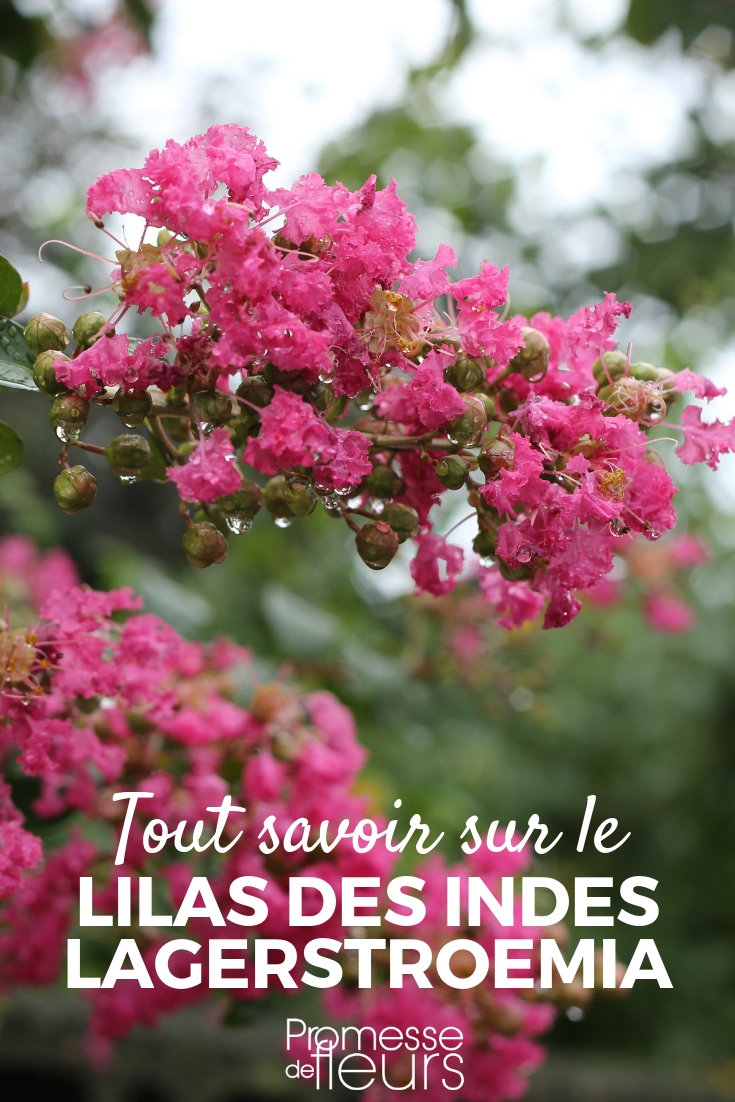































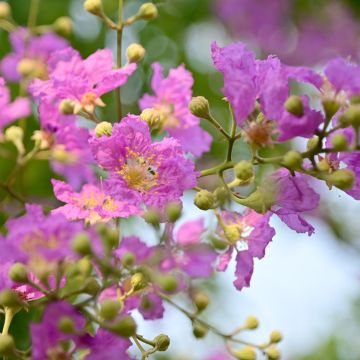
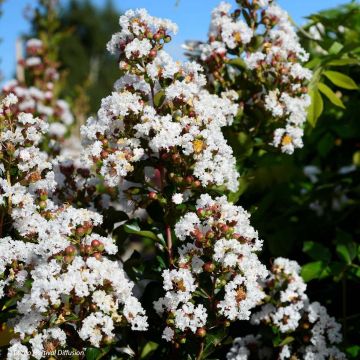
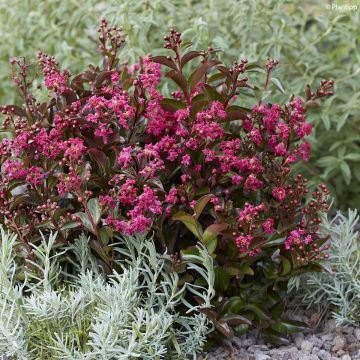
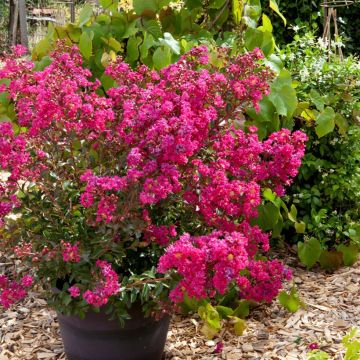
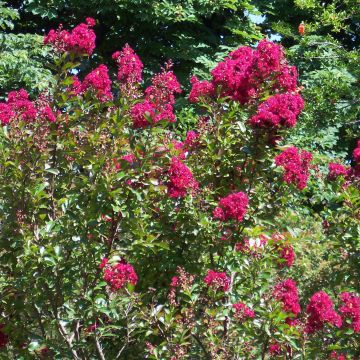

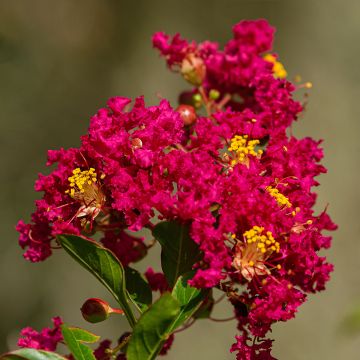
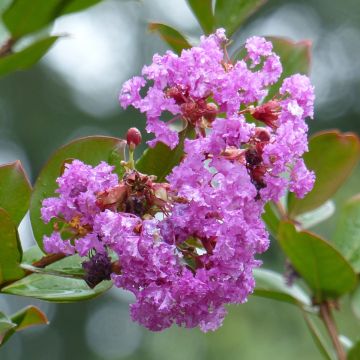
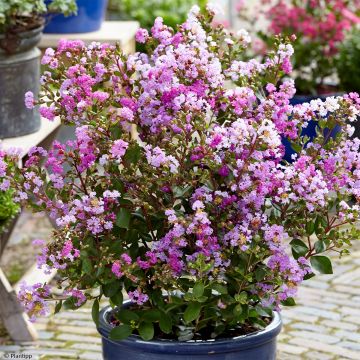

Comments